Marketing Festival is now over, and we assume that this year’s line up, starting with Rand Fishkin and ending with Oli Gardner, didn’t disappoint anybody.
Jindra Faborsky did an outstanding job again of organizing everything, and we can’t thank him enough. But we can keep buying tickets for upcoming years, so hopefully, it will help 🙂
We enjoyed the talks by Rand Fishkin and Filip Podstavec the most, as we are also SEO oriented. But we were also inspired by the talk from Avinash Kaushik, that was a wake up call for most of us, and also by an exceptional talk from Oli Gardner.
During the whole day, we did our best by tweeting and live blogging here (at the end of the page). But we have also put together all of our notes from the talks here in this post.
The Invisible Giant That Mucks Up Our Marketing
Rand Fishkin, Moz.com

Rand Fishkin is the founder and king of the SEO empire Moz. In his presentation “The Invisible Giant that Mucks Up Our Marketing,” he talked about the cognitive biases and cultural pressure that create logical fallacies in our marketing brains.
The core message:
Solve the searcher’s problem better than other pages on the first page of Google.
Notes from the talk:
1. Myth: Investments must be measurable.
There are both easy and hard measurable marketing channels in online marketing:
Easy measurable marketing channels:
- PPC
- Social media
- Retargeting
- Emailing
- Direct mail
Hard measurable marketing channels:
- Word of mouth
- SEO
- Organic social media
- Content
- Public relations
If you want to make money from your ads, invest in measurable channels. Paid channels are more easily measurable than organic sources. And as more measurable it becomes, the more money is spent.
Tip for you: Invest in hard measurable channels, because it is worth it.
2. Myth: Channels must be ROI-positive.
- MOZ’s Whiteboard Friday was the worst performing channel in 2008 and the best-performing in 2017.
- They had negative ROI for at least 18 months.
- Tip for you: Focus on potential and measure against trajectory. After three months of work, you’re on a powerful trajectory, even if it is not ROI-positive yet.
3. Myth: Search investments are either SEO or PPC.
- But: SEO and PPC are only 54.7% of all Google results.
- 11% of the clicks go to results that are not SEO or PPC. For example:
- Knowledge panels
- Related questions
- Local packs
- Images
- Site links
- Featured snippets
- Top stories
- Videos
- Tweets
- “People also ask”
- Instead, consider focusing on:
- Google images (21% of overall traffic)
- Google maps and local results
- YouTube
- SERP features that show up in your keywords
- Amazon, Facebook and Bing
- Where search demand originates
- Images don’t bring too much traffic, but can be powerful in e-commerce tied with visuals.
- People take stuff from Google images, not from your site. Try to add some catchy saying on the image with a call to action, so they can click through.
4. Myth: Content marketing means publishing only on your website.
- This is not necessary. It also doesn’t apply when your site is new, light on link authority, lacks a usable CMS, subject to nasty legal or brand restrictions, etc.
- You can do guest blogging on strong pages which rank high.
- 6 broad websites that are currently ranking high, where you can share your content:
- Quora
- YouTube
- Slideshare
5. Myth: Google rankings = links, keywords & tech issues.
- There is a new searching factor called “Searcher task accomplishment.”
- SEO in 2012: Earn more links with more exact anchor text than your top 10 competitors.
- SEO in 2018: Solve the searcher’s problem better than other pages on the first page on Google.
- There are types of results that are worth focusing on. Analyze which types of SERPs appear most in your keywords and try to get there.
Tweets from the talk:
Add CTA directly on images, best clickbaiting strategy for image search #mktfest pic.twitter.com/MDsHzzITnA
— Pavel Ungr🔍 (english) (@PavelUngr_Eng) November 10, 2017
“If you are working more than 50 hours per a week, it means you are bad at your job” @randfish #mktfest #mktfest17
— Spotibo (@Spotibo_tool) November 10, 2017
Q&A
Q: How did speed test manage to outrank the one box?
A: Speed test utilized a lot of brand building so they could outrank Google’s box. Speed test was featured in Iron Man, for example. Speed test doesn’t mean a broad search query, but it is a brand search now.
Q: What was your biggest fuckup?
A: Most expenses went to conferences, and we spent money on sponsoring events. It is maybe great for software companies, but not for MOZ.
Slides:
Right Research, Right Value
Kim Goodwin, Cooper

Kim is the author of the book, Designing for the Digital Age, which has become a go-to bible for designers worldwide. She talked about planning more effective formative research, getting the most out of every session and figuring out as a team where to go next.
The core message:
Surveys are not helping. Instead, we need to ask real human beings questions and observe.
Notes from the talk:
- You usually want to connect with your customer and set expectations at the right value. But no! It’s vice versa.
- Surveys = They are good for facts, but they are terrible at predicting behavior. The survey is based on the ability of people answering the questions, which can often be misleading.
- Don’t outsource your research. It is like outsourcing your vacation.
- Start doing research WITH your clients, not FOR them.
- In her experience, 6-20 interviews are enough to see patterns.
- Try to find customer’s experience goals.
- Ask questions: What they do, with whom, where, when, how and why? How do they want to feel? Exited or safe?
- Potential value propositions. Help improve the journey. As an example, in airlines, the customer’s pain is visa, weather, booking a car, meals and security. Can airlines cover these and provide help for them?
- Help influence decisions. “A person like me” is contextual. Customers like to share their needs with like-minded persons.
Recommended books:
- Designing for the Digital Age, Kim Goodwin
- Interviewing Users – Steve Portigal
- The Ethnographic Interview – James P.Spradley
- How to Get People to Do Stuff – Susan M. Weinschenk
Tweets about the talk:
When you make a research you need the right questions to be answered. @kimgoodwin at #mktfest pic.twitter.com/hnR4wiRO3B
— eVisions.cz (@eVisionscz) November 10, 2017
User interviews can help identify gaps in users’ needs & optimize marketing value props but NEVER outsource your research. @kimgoodwin #mktfest
— Shape (@shape) November 10, 2017
Q&A
Q: Who should we interview?
A: Keep in mind that it is a qualitative research. It doesn’t have to be completely representative. You can use typical researching tools.
Q: How do you quickly convince B2B sales stakeholders?
A: Don’t ask for permission and just do a few interviews. And bring some nuggets from that interview. If we get more interviews, we can find out more.
We Must Scare Our Clients
Joe Wade, Don’t Panic

Joe claims that “We Must Scare Our Clients,” and that in today’s market, the biggest risk is not taking the risk. Joe is a co-founder of creative agency Don’t Panic, which is responsible for some of the most successful and viral advertising campaigns.
The core message:
In ads, hearts persuade minds.
Notes from the talk:
- Ads are mostly rubbish: A majority of online advertising is “digital landfill.”
- 60% of branded content on Facebook isn’t viewed or engaged with.
- 23% of content generates an above-average emotional response.
- 33% of viewers lose interest after the first 30 seconds of watching videos.
- Sometimes marketers think an ad is great, but people’s responses don’t need to be good, and don’t need to be accepted. Nivea, Pepsi and McDonald’s have had some advertising fails.
- People are blocking more ads with ad blockers (408 million mobile users as of March 2016), so marketers have to create more and more ads. Many ads are produced and people often don’t see them. The ads go straight to rubbish.
- A few tips on what to do:
- Make adverts more artistic again.
- Hearts persuade minds. Very story-led, easier to engage them and remarket them again, mainly on social.
- Imagine there is no media budget.
- Stories are the oldest, most innate viral content.
Tweets about the talk:
"It's ok if people hate your adverts as long as you audience love them." @Mrjoewade #mktfest #mktfest17 #mktfest2017 #wordsofwisdom
— pwlina (@pwlina) November 10, 2017
Shares are more valuable than views. You can't buy them. @Mrjoewade na #mktfest17 #mktfest
— Marketing Journal (@MjournalCZ) November 10, 2017
Ads from the talk:
AI and Machine Learning: Implications on Business, Marketing & Analytics
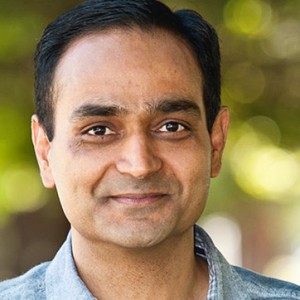
Avinash is the author of the famous and most frequently used marketing framework See, Think, Do, Care. He is an exceptional speaker and marketer.
The core message:
Using Machine Learning is not some future fantasy. It is happening now, and your company is probably already far behind.
Notes from the talk:
- What intend are you targeting? Ask yourself that every time you’re buying a place on a billboard, TV or social.
- Examples of AI (Artificial Intelligence):
- Google Photos is able to recognize all the content on its own. When you type the name of who you are looking for in the search, you get all the photos back! If you type a name and the word beach, you get pictures of a person on a beach. You can even track all the history of a person. That is magic, right?
- A neurologist can expose if his patient has a stroke in 30 to 60 minutes according to the X-ray. How much time does it take with AI? 15 seconds!
- Deep Learning is a specific Machine Learning technique which currently powers the most exciting applications of Artificial Intelligence.
- In the past, for some projects, you needed hundreds of engineers. Today? You can use TensorFlow, an open source SW library for ML- Software for neural networks.
- 20% of your customers probably make 75%-80% of the profit. Analyze data from that 20 % of your customers, because they are responsible for your revenue.
- Usually, after running an ad campaign, you evaluate 5-6 signals, but there are 3K signals.
- In analytics, there is Analytics intelligence, which helps you understand what data you should look at more and what data you are not focused on enough.
- #lessdatapuking:
- Yesterday: Data collection = 50%, Data reporting = 40%, Data analysis = 10%.
- Tomorrow: Data collection = 10%, Data reporting = 10%, Data analysis = 30%, Taking actions = 50%.
- Analytics were meant to make smarter decisions, but analytics as we know them will go away. It will be automated, scaled, faster and deliver a higher impact.
- If your company’s data is not limited, and you don’t want to guess how much credit to give each marketing strategy, ML powered attribution can analyze every individual’s journey and automatically recommend shifts to your media budget.
- Avinash expects that some humans will still be required to fill some professions. But anything that is done often in a repeatable manner is already on its way to being replaced.
- Analytics is making smarter decisions. It will be automated, scaled, faster and deliver a higher impact. ML can do that a million times better than you, and can also take the necessary actions.
Tweets about the talk:
New goals for next year from @avinash to all marketers #mktfest #mktfest17 pic.twitter.com/dc1HcevzIk
— Spotibo (@Spotibo_tool) November 10, 2017
“Doing just organic content on Facebook is like flushing money down the toilet. “ @avinash #mktfest17
— Marketing Journal (@MjournalCZ) November 10, 2017
There is a difference if you build something in 5 years or 5 month.
by @avinash #increasevelocity #mktfest #mktfest2017 pic.twitter.com/AaPWFqUHzT— Karel Navrátil (@karelnavratilcz) November 10, 2017
Useful links:
Marketers Are From Mars, Consumers Are From New Jersey
Bob Hoffman, The Ad Contrarian
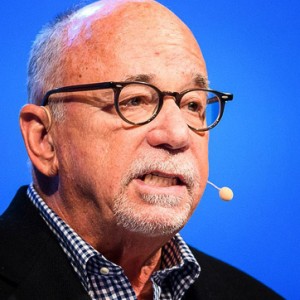
Bob is the author of many great books, one of which is Marketers Are From Mars, Consumers Are From New Jersey. His views differ from the mainstream, and his Twitter bio says: “Making marketers uncomfortable since 2007.”
The core message:
Marketers underestimate the power of traditional consumer behavior.
Notes from the talk:
- Knowing something is completely different from thinking you know something.
- What questions marketers ask:
- How can I engage consumers with my brand to create a community?
- How can I co-create with my target and develop a conversation?
- What questions consumers ask:
- Is there going to be parking?
- Is this thing going to work?
- Is there anybody who knows what he is talking about?
- Consumers want clarity and simplicity, but marketers want complicated stuff out of everything.
- There are many people proclaiming that advertising and television are dead.
- Death by advertising? You can’t kill advertising!
- “On that final day when the big flaming asteroid bears down here, there’ll be only two things left: cockroaches and copywriters.”
- Death by interactivity? Consumers have demonstrated almost no interest in interacting with the advertiser. For example, display ads have 6 clicks per 10,000 impressions, at average. That is the absence of interactivity. It’s also very bad that even these few interactions that do occur are fraudulent. One Google study recorded that more than half of display ads paid for by advertisers are not viewable and never appear in front of a live human being.
- The brand is not loyalty. It is a habit. If Pepsi would disappear tomorrow, most Pepsi loyalists would switch to Coke with very little psychological damage.
- “In Europe and the U.S., people would not care if 92% of brands disappeared.”
- Having a strong brand should be the highest goal, but that is all. People don’t love your brand, instead, it’s only their satisfaction to buy the products.
- Customers don’t care about the brand. The marketer has to prove its value every day of the year, reminding the world once again why they should buy their stuff.
- Why advertisers spend so much time, money and energy talking to young people and so little talking to old people? There are no facts confirming that it is a good strategy.
- People over 50 are the most valuable generation in history, as they are responsible for 51% of all spendings.
- In the US, people over 50 own 70% of the wealth.
- But marketers hate old people; they are not cool, after all.
- Final thought: Be a sceptic. If somebody says something, it doesn’t mean it’s the truth.
Tweets about the talk:
You are more likely to complete Navy Seal training than click on a banner ad @AdContrarian #mktfest
— 💭 Jiří Urban (@urbanjiri) November 10, 2017
Marketers are targeting and chasing millenials but forgetting about the people over 50. And they are much more wealthy! @AdContrarian at #mktfest #mktfest17 pic.twitter.com/yHfDAy7CDu
— Spotibo (@Spotibo_tool) November 10, 2017
Fighting Ad-Fraud: Understanding Monetization of the Internet
Shailin Dhar and Praneet Sharma, Method Media Intelligence
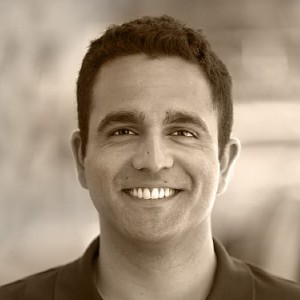
Shailin and Praneet are the founders of the consultant agency, Method Media Intelligence. They talked about fighting ad-fraud and how to prevent money leaking on digital ads.
The core message:
Ad technology companies make the same proportion of money from robotic traffic as from human web traffic.
Notes from the talk:
- Web traffic can be anything from a browser, server request or an app that calls out to many servers. The protocols of the internet are fairly agnostic and open. This has resulted in wide adoption.
- The familiar notion of “web traffic” is usually page views.
- Financial incentives in the Ad Industry:
- Publishers: Sell as much advertising as possible.
- Advertisers: Drive maximum value from media investment.
- Agencies: Generate margin by planning / executing media buying for advertisers.
- Ad Tech: Process and serve as many impressions as possible.
- Fraud Detection: The existence of bot traffic makes them valuable.
- 38,5% of traffic is human. 61,5% of traffic is non-human.
- Money in ad-fraud:
- $8,2 billion lost to ad-fraud
- 4,1$ lost to NHT
- $169 million spent on fighting fraud
- Knowing the difference between what you intended to buy and what was supplied to you is vital to every business, not just advertising.
Tweets about the talk:
Bots and AD manipulation creates a lot of misleading information and stats …and jobs 🙂 @ShailinDhar #mktfest #mktfest17 pic.twitter.com/eerhDtbGNH
— Matej Kukucka (@MatejKukucka) November 10, 2017
Enhancing creative content with neuroscience
Dr. Bradley Vines

Dr. Vines is the Director of Neuroscience Europe at Nielsen. Bradley shared the most cutting-edge research on consumer behavior with a few juicy case studies.
The core message:
There is no significant difference between emotional and rational ads.
Notes from the talk:
Dr. Vines showed us a case study of the following ad:
- 63% of respondents thought that the ad is creepy, weird or disturbing. They didn’t like it.
- At the end, it was the most tweeted-about ad of the 2016 Super Bowl, and it caused a 34% sales lift in Q1 year-on-year.
- Consumer Neuroscience tools supporting better advertising are:
- EEG (multiple sensors to measure motivation, memory and attention)
- Facial coding (Expressed emotions – positive, negative and neutral)
- Eye tracking (Visual focus on content)
- EEG:
- Measures emotional motivation, memory activation and attention processing.
- It can answer questions like: Does your ad activate your brand? Does a person have a big association with a brand?
- People are emotionally approached to the ad.
- EEG emotion trace can show how people react, what are the effectiveness, attention, emotional engagement, senses, reactions and memory activation.
- It is a great tool for developing better copy, telling us where to cut off some parts and create an even better ad.
- The contribution of campaign elements to driving sales:
- Creative 47%
- Brand 15%
- Reach 22%
- Recency 5%
- Targeting 9%
- Context 2%
Tweets about the talk:
Brains are similar around the world @bwvines #mktfest2017 #mktfest.
— Jan Januska (@JanJanuska) November 10, 2017
"Look! Combination of these aspects will affect the future." #mktfest #mktfest17 pic.twitter.com/iMHqeBMDGD
— Matej Kukucka (@MatejKukucka) November 10, 2017
Emotional ads are not more successful than rational ads. In fact, impressions of these ads are quite identical, Dr. Bradley Vines says. Interesting finding at #mktfest, #mktfest2017, @bwvines
— Milan Fiala (@fiala_milan) November 10, 2017
Get inside the head of a crawler
Filip Podstavec, Marketing Miner

Filip built a successful tech startup, Marketing Miner, which can find valuable data about keywords, URLs or domains. At his talk, Filip advised many tools and concepts which can help you to make your website much more accessible.
The core message:
Don’t underestimate your log activities.
Notes from the talk:
- To get inside of a machine head, SEOs can do something similar to what scientists can do with human brains.
- Higher crawl rate, more indexed pages, make a website faster, cleaner architecture. This leads to boost organic traffic.
- Higher crawl rate is not direct ranking signal.
- “Crawlers choose the paths that grant the greatest rewards for the least amount of effort”.
- Crawl budget can be, let’s say 500 hundred pages in a day for the Marketing festival website (more or less).
- Website diagnosis:
- Bot requests
- Googlebot agents
- Most visited URLs (robots.txt)
- Status codes
- Googlebot errors
- User errors
- IP requests
- Googlebot IPs
- Most of these requests are made by bad bots.
- 61.8% of your traffic are bots!
- If you have the log, identify some of these bots, disallow user agents from tools you don’t use and suspicious IPs. There are bots hiding behind Googlebot IP, so check the IPs list and identify it.
- What can you do in crawl budget optimization from the technical point of view?
- Monitor your server and stay updated on what’s happening in there.
- Beware of any slow down.
- Be in touch with somebody responsible (with your sysadmin).
- Identify suspicious agents and disallow them.
- Not every URL should be crawled and indexed. Filter them.
- Beware of mistakes in internal linkings.
- Sanitize the pagination with rel=”prev”, rel=”nex”,.
- Monitor filters, delete unused filters (CSS – use checkbox elements that Google cannot follow).
- Avoid thin content crawling, disallow them in robots.txt and do not use noindex.
- Keep your sitemap clean with only indexable URLs.
Recommended tools:
- Log managers: loggly, logmatic.io, logentries, logz.io, graylog, splunk
- Elastic stack for log management (Elastic, logstash, kibana)
- Website monitoring services: Pingdom, Testomato, UptimeRobot
- Pagespeed checkers: Pingdom, WebpageTest, Google PageSpeed insight
- Tool for improving the quality of web pages: Google Lighthouse
Tweets about the talk:
Logs are very powerful and underestimated source @filippodstavec at @mktfest #mktfest #mktfest17 pic.twitter.com/if2SaKaVyK
— Lukas Teply (@LukasTeply) November 10, 2017
Do you want to analyze your log files? @filippodstavec has prepared a big gift for you! Look at this URL: https://t.co/QPCwpFIOxt #mktfest #mktfest2017 pic.twitter.com/RLl8cfQLli
— eVisions.cz (@eVisionscz) November 10, 2017
Slides:
Slides, information, tools, and answers to the questions from Sli.do from Filip are here.
Data-Driven Design
Oli Gardner, Unbounce

Oli is the co-founder of Unbounce and a master in creating landing pages that bring more conversions. He spoke up about how to use our data and make changes to digital marketing.
The core message:
The synergy of designers, copywriters and marketers is important. It leads to a higher conversion rate.
Notes from the talk:
-
- 98% of marketers said they are responsible for giving design feedback to designers.
- 87% of them believe they are qualified to do that (it’s bullshit).
- Designers are problem solvers, meaning we are all designers.
- Oli’s playbook is a framework – a way how to get a more team collaborative process, where everyone gets involved.
- It looks complicated, but it really isn’t. You choose your object of interest in 1. column, for example, “form,” and then you choose data source or UX method which helps you create a better design, for example, “click map”:
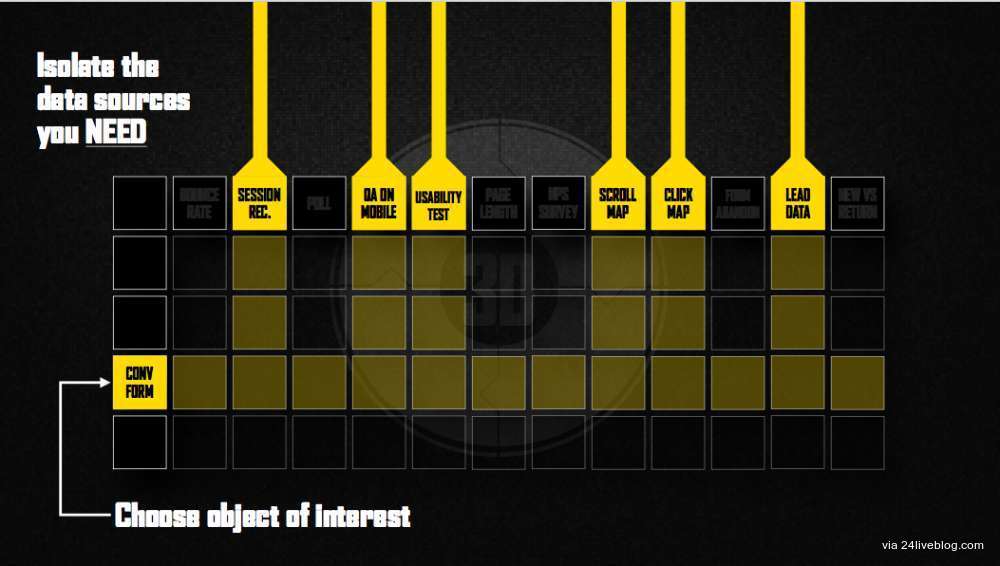
- In a spreadsheet: Choose an object of interest in the first column like “footer.” Then see to the cells with green background in that row with “footer” and use testing tactics. It is clicks and scrolls in heatmaps.
- In each cell with the green background, note how and why to check that:

- 4 steps:
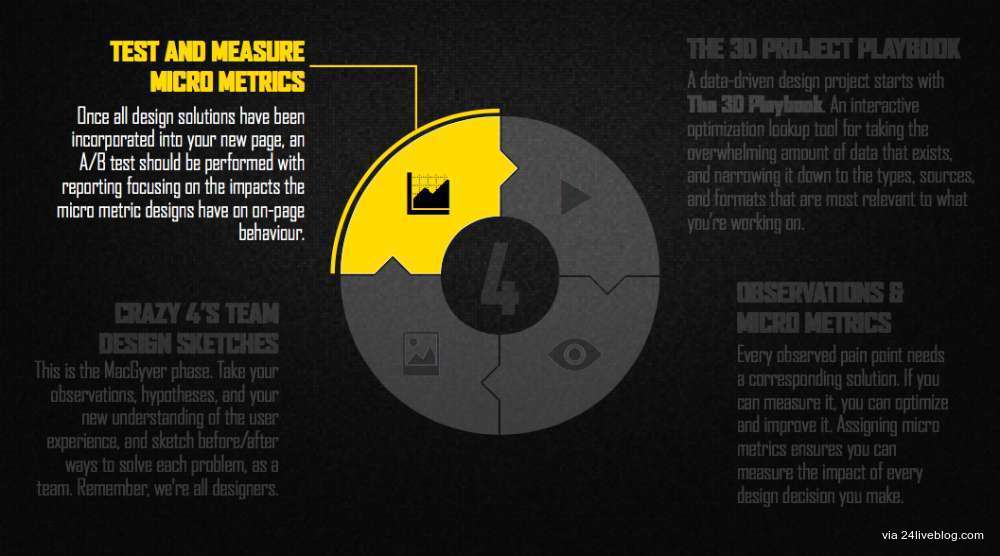
Tweets about the talk:
Oli rounding out the conference ❤️ #mktfest 🇨🇿 https://t.co/S29WgZUqs8 pic.twitter.com/6TfJDyzwTw
— Nicole Mintiens (@Nicole_Mintiens) November 10, 2017
#micro-metrics measure how your #design decisions impact #on-page behavior. @oligardner on #datadrivendesign #mktfest #mktfest17 pic.twitter.com/XOFV15GF3t
— pwlina (@pwlina) November 10, 2017
We all are designers. It looks like there is a piece of MacGyver in each of us 🙂 Data-driven design by @oligardner at #mktfest Isn’t he just awesome? 😉 pic.twitter.com/X12IQL5iwQ
— Dotidot (@dotidotofficial) November 10, 2017
Slides:
Gift for all attendees
Sign up at Spotibo anytime until Tuesday and you will get 1000 URLs to analyze for free.
Other articles that we find interesting
- EN: Top 10 Inspiring Thoughts from Marketing Festival #mktfest17, gfluence.com
- EN: Marketing festival 2017: The digital side of Prague, mozaik.com
- CZ: Marketing Festival i v roce 2017 obhájil svou pozici na špičce, Pavel Ungr
- CZ: Marketing Festival 2017 – Novinky z onlajnu #Speciál, evisions.cz
(note for English speaking readers: The whole video is in Czech, but you can find there two videos with Rand Fishkin and Cyrus Shepard in English). - CZ: Marketing Festival 2017 a co nás nejvíc inspirovalo, sunitka.cz
- CZ: Marketing Festival 2017 z jiného úhlu, activate.cz
- CZ: Online marketing jako podvod desetiletí a můj 1. #mktfest, Anna Sálová
- CZ: Co si odnést pro copy&content z Marketing Festivalu 2017, Obsahová agentura
- CZ: Marketing Festival 2017 aneb návrat k zákazníkovi, impnet.cz
- CZ: Ohlédnutí za letošním Marketing Festivalem, mediaguru.cz
- CZ: Výběr z bobulí Marketing Festivalu, Proficio
- SK: Marketing Festival 2017: svetoví spíkri a nové trendy, darencurtis.sk
- SK: Piaty Marketing Festival … Aký bol?, Performics
- SK: ČO VÁM DAL MARKETING FESTIVAL, AJ KEĎ STE NA ŇOM NEBOLI?, Elite Solutions
- SK: Marketing Festival v kocke, Nice Agency
Entries from Live Blogging
Introduction to Live Blogging
In just a few days, you will find live entries from the Marketing Festival conference right here.
Are you asking how? We will be doing live blogging.
Hmm … what exactly is this live blogging about?
Well, it is the same as blogging, but live. 🙂 We will write our notes from the speaker’s talks directly on the blog, and we will tidy up this post later after the conference. So please, forgive any misspellings or other small mistakes.
I am going to the Marketing Festival as well. How will it help me?
You can find all of the important links to the sources here, so you don’t have to remember all of the bit.ly links. We will also share the best tweets with the hashtag #mktfest.
Or perhaps you may be unsure about your English. In that case, you will find some important and interesting information here, that maybe you misheard.
We are a team of three people, so we will do our best to catch everything important in this post. You can also contact us, tweet to us or talk to us in person.
It’s a shame, but I am not visiting this year.
Sorry to hear that. However, this post will probably be even more useful for you. You can just check our page for the regular update, and it will be almost like you are there with us. Afterwards, you can find the full report of the conference here.
Cool beans! What now?
- If you have other questions or just want to get in touch, you can contact me at gabka@spotibo.com.
- You can also support us by tweeting about this.
- And the most important one – come back to read this live blog post on 10. 11. at 9:00.

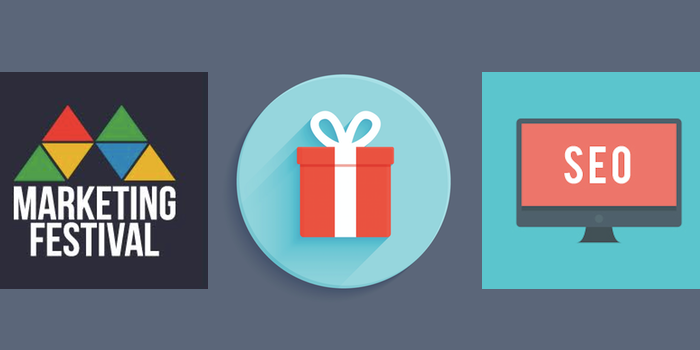



3 comments
Thomas
I need to be there next year!